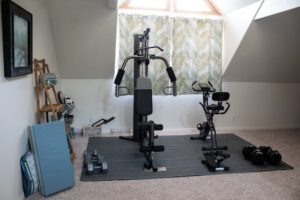Are you getting the most out of your at-home workout routine?
If you’ve gotten into the habit of working out at home, you may be looking for a little variety in your fitness routine. While plenty of yoga, Pilates, and exercise classes are available in various formats online, it’s important to remember that you’re getting a balanced workout.
In this article, we’ll look at the fundamental movements to include in your workouts and some low-key, easy-to-manage, and affordable equipment options that might help you get a well-balanced exercise session every time.
And best of all, you can practice these movements in the convenience of your home.
We’ll also provide some resources for older people or those new to home exercise at the end.
The Main Movements That Your Body Needs
When you think of “bodyweight workout,” a couple of fundamental exercises, like squats, pushups, and planks, will likely come to mind. While these are all great exercises, your body moves in many different directions and dimensions, so there are other things to consider when doing a home workout.
For example, take a moment to think about a pushup. You’re repeatedly pushing, which is excellent for your pushing muscles—but what about your pulling muscles?
Your body needs to be able to squat to strengthen the hips and knees on the front side of your legs, and you also need to keep your chest and shoulders strong on the front side of your chest. However, it’s essential to strengthen both sides of your body, front and back.
Here are four simple exercises you can do at home with very minimal equipment:
Bodyweight Rows or Exercise Tubing Rows
These are great exercises to strengthen the pulling muscles on the backside of your shoulders. One of the tough things about pulling exercises is that you need something to pull on.
Fortunately, elastic exercise tubes are widely available and versatile for various exercises. In this case, you can loop the center of the band around a sturdy stair rail or some other anchored object. Step back a few feet, facing the anchor with a handle in each hand, then pull the handles towards you. You can step forward or back to increase or decrease resistance.
Option two is to find an affordable suspension trainer, like TRX, and anchor it at the top of a closed door. Hold a handle in each hand, and step forward until you hang back with your weight supported by the straps. “Row” your body weight for as many reps as you can complete comfortably.
Both pieces of equipment are affordable, minimal, and easy to store.
“Good Mornings” and Raised Hip Bridge
Like push is the opposite of pull, the complimentary movement to a squat is a hip hinge targeting your glutes and hamstrings. Fortunately, these exercises require even less equipment. A simple yoga mat can be helpful, but that depends on your comfort level on the floor.
First, “Good mornings” are a simple exercise to strengthen the backs of your hips and thighs:
Start standing up tall with your hands on your hips. Bend your knees slightly, then bend at your waist with a flat back until your chest faces the floor. Then, with a big exhale, pull yourself to standing. You can place your hands behind your head to make this exercise more challenging but be aware of neck discomfort.
While you’re likely to feel that movement most in the backs of your thighs, the following exercise heavily targets both the thighs and the glutes.
For the raised hip bridge, set a sturdy chair at the front edge of your yoga mat on the floor, then lie down on your mat with your feet facing the chair. Having your chair against a wall is best, so it doesn’t move. With bent knees and your back flat on the floor, place your heel on the chair seat. Simply lift your hip off the ground until you feel engagement on the backs of your hips and thighs, then slowly return to the start position.
If you feel discomfort in your neck or back, you can scale the exercise to the floor by doing a simple floor bridge (without the chair) to make it less intense.
You can repeat these exercises as many times as you need.
Hopefully, this article illustrates how little you need to get an excellent daily home workout. Add your favorite core exercises, and you will have a well-rounded full-body workout to energize you for the rest of your day!
If you’re a senior exerciser or new to exercise, Physioed.com is a go-to resource for fitness basics, designed and reviewed by practicing doctors of physical therapy. They provide free classes, all the information you need to exercise safely at home, and many other helpful tools to prevent and manage injuries.

